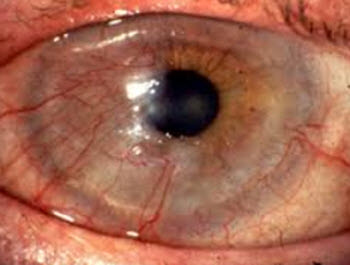What is corneal neovascularization?
 Excessive ingrowth of blood vessels from the limbal vascular plexus into the cornea. (The cornea is the transparent dome that covers the iris, the pupil and the anterior chamber of the eye.)
Excessive ingrowth of blood vessels from the limbal vascular plexus into the cornea. (The cornea is the transparent dome that covers the iris, the pupil and the anterior chamber of the eye.)
Corneal neovascularization is a symptom of your corneas not getting enough oxygen from the air (corneal hypoxia). The body is trying to compensate by growing more blood vessels that can bring oxygen to the cornea.
Advanced corneal neovascularization can be a threat to your eyesight.
How can I prevent corneal neovascularization?
While there are a lot of things that can cause corneal neovascularization, including the herpes simplex virus, the most common reason is corneal ulcers or using CL:s in away that starves the cornea of oxygen. So, the best prevention is to not use CL:s in a way that increases the risk of corneal ulcers and also never use CL:s in away that starves the cornea of oxygen.
- If possible, use CL:s with high gas-permeability. The more oxygen that can pass through the lens, the less risk of corneal hypoxia.
- Never sleep with CL:s that aren’t designed for sleep.
- Sleeping with CL:s will increase the risk of corneal neovascularization, because when the eye is close, the tear liquid can not absorb oxygen from the air and transport it to the cornea. When your eyes are closed, the cornea must get all the oxygen it needs from blood vessels on the inside of your eyelid. If you have a CL that doesn’t let enough oxygen through, this will lead to corneal hypoxia.There are modern silicon hydrogen CL:s that can be safely used during sleep, but it is extremely important to follow the manufacturer’s recommendation for how long you can keep them in.
- To further decrease the risk, switch between using CL:s and eyeglasses. You can for instance use Daily Disposables during the day and then sleep without CL:s. If you need to check on something during the night, use glasses instead.
- To prevent serious corneal neovascularization from developing, anyone who uses CL:s should have their eyes checked by an eye care professional, such as an optician, at least once a year. During the exam, it is possible to detect early signs of corneal neovascularization that aren’t causing any symptoms yet. The eye care professional will be able to warn you and advice you about how to proceed to reverse the situation.
This article was last updated on: April 24, 2016

